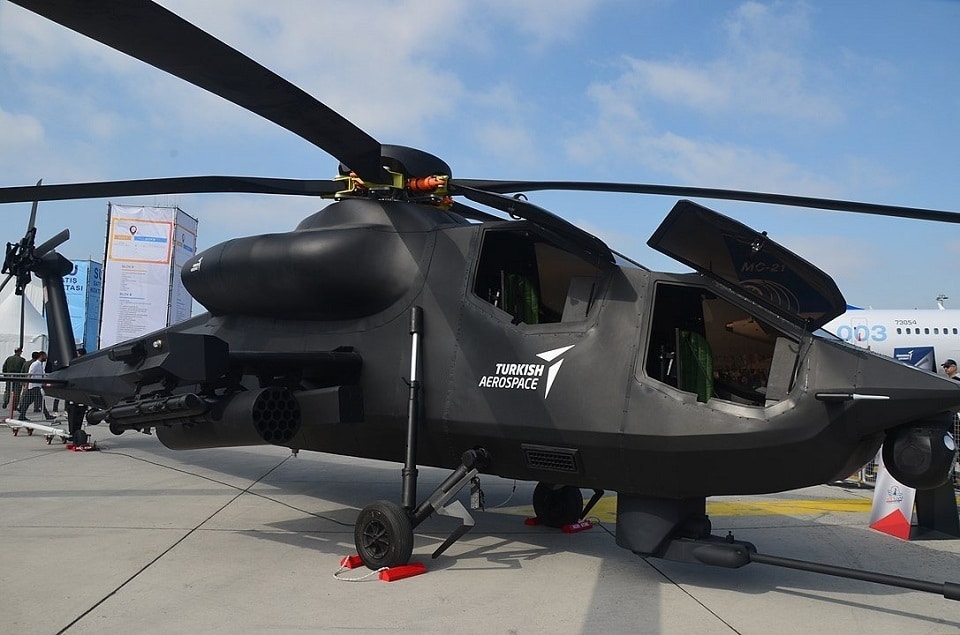Aerospace
Turkey unveils ATAK II helicopter with Ukrainian engines to compete with AH-64 Apache

Turkey recently unveiled the ATAK II helicopter, marking a significant advancement in the field of advanced military aircraft. This cutting-edge rotorcraft represents a formidable contender in the world of attack helicopters, poised to challenge the long-standing dominance of the renowned AH-64 Apache.
Turkey unveils new T929 heavy attack Helicopter(Opens in a new browser tab)
A strong competitor to the AH-64 Apache, the ATAK II has a number of advancements over its predecessor. It has an improved avionics system, a more potent engine, improved survivability features, and a longer mission range. The ATAK II can now operate successfully in a variety of combat situations, such as close air support, anti-armor missions, armed reconnaissance, and missions.
With a range of innovative features, enhanced capabilities, and state-of-the-art technology, the ATAK II is a testament to Turkey’s commitment to indigenous defense production and its ambition to secure a prominent position on the global military stage.
Comac launches freighter conversion programme for ARJ21(Opens in a new browser tab)
The ATAK II is an upgraded version of the original T-129 ATAK helicopter, which was jointly developed by the Turkish Aerospace Industries (TAI) and AgustaWestland (now Leonardo) of Italy. The original ATAK was itself an impressive attack helicopter, but the ATAK II aims to further enhance its combat capabilities and address any shortcomings identified through operational experience.
The ATAK II, which will make its maiden flight in the spring of 2023, is powered by two Ukrainian TV3-117 engines that have a combined output of 2500 hp. TAI and SBS are creating the ATAK II. A payload of 1500 kg is possible for the helicopter. 11,500 kg is the helicopter’s highest allowable takeoff weight.
For both Ukraine and Turkey, ATAK II is crucial. While the latter will attempt to gain market share on a worldwide scale, the former will be able to promote its propulsion systems. With a maximum take-off weight of 9,500 kg and 7,000 kg, respectively, the new helicopter is positioned as a rival to the AH-64 Apache.
A brand-new T929 attack helicopter also offers the first clear view of the nearly finished prototype. The rotorcraft, created under the ATAK-2 program and powered by Ukrainian-made engines, is anticipated to be handed to the Turkish Army starting in 2025, according to officials.
Chinese ‘flying car’ makes first public flight in Dubai(Opens in a new browser tab)
The cockpit has a big area display and can withstand ballistics up to 12.7 mm bullets. Six weapon stations, including freefall bombs, guided air-to-surface and air-to-air missiles, and guided and unguided rockets, are located on the stub wings, which can hold up to 1,200 kg of armaments. In addition, it has an Aselsan forward-looking electro-optic/infrared turret and a T-30H 30 mm chain cannon positioned on the chin.
This ATAK II helicopter could be a competitor to Apache and Russsian Ka-52 Kamov. The latest helicopter can be upgraded with advanced weaponry and avionics which is developed by Turkish aerospace and it will look forward for international customers for this helicopter Indonesia, Pakistan, and Egypt countries.

Aerospace
When Ratan Tata was denied entry to the airfield at the Aero India show, he waited

During our visit to Aero India 2019, we had the unexpected opportunity to see Ratan Tata at the event, which was a thrilling moment for us. However, there was a surprising hiccup when the security staff didn’t allow him to enter due to a lack of a security pass.
Despite this, he remained calm and patiently waited for about 20 minutes until a member of the Tata team brought him the required pass, after which he calmly proceeded inside. It was a humbling sight, showcasing his composed demeanor even in such situations.
Ratan Tata ji is not only a renowned industrialist but also a trained pilot, holding a pilot’s license. In 2007, he became the first Indian civilian to fly the F-16 Falcon during the Aero India show in Bangalore—a proud moment for the nation.
His passion for aviation extended beyond flying, as he played a key role in shaping India’s aerospace industry. Under his leadership, Tata ventured into manufacturing and maintaining aerospace components while upholding its legacy of quality. Notably, Tata’s collaboration with Airbus to develop and manufacture the C295 aircraft is a testament to its growing influence in the sector.
-

 Aviation2 months ago
Aviation2 months agoMicrosoft Flight Simulator Raises $3 Million to Bring Back the An-225 Mriya
-

 Airlines2 months ago
Airlines2 months agoQatar Citizens Can Travel to the United States Without a Visa
-

 Aviation2 months ago
Aviation2 months agoQatar Airways bans these new Electronic Devices on plane
-

 Airlines2 months ago
Airlines2 months agoJapan Airlines Rolls Out Free Domestic Flights to International Passengers
-

 Defence2 months ago
Defence2 months agoWhich Country Has the Largest Fleet of Fighter Aircraft?
-

 Airport2 months ago
Airport2 months agoWestern Sydney Airport Welcomes Its First Plane After 6 Years of construction
-

 Travel2 months ago
Travel2 months agoQatar Airways Launches Four Additional Flights from Amsterdam
-

 Aviation2 months ago
Aviation2 months agoDid you know ? Once Boeing 747 carried 1088 passenger in 1991








